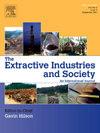应如何管理尾矿设施的社会-地域密度?关于智利矿业政策的建议
IF 4.3
2区 社会学
Q2 ENVIRONMENTAL STUDIES
Extractive Industries and Society-An International Journal
Pub Date : 2025-08-05
DOI:10.1016/j.exis.2025.101748
引用次数: 0
摘要
全球能源转型加剧了对关键矿物的需求,加速了采矿活动和尾矿设施的扩散,特别是在全球南方。虽然国际研究集中在技术和公司治理方面,但对国家规模的公共政策框架的关注有限。本文将智利作为一个极端采矿强度和尾矿堆积的案例,提供了基于gis的764个注册设施的空间分析。利用核密度和空间聚类技术,我们确定了基础设施积累的两个主要区域和五种社会领土模式:(i)影响较小的低密度区,(ii)远离水道的低密度区,(iii)具有区域影响的高密度区,(iv)影响城市住区的高密度区,以及(v)关键高密度集群区。这些模式揭示了社会-地域不平等和环境暴露区。基于这些证据,我们批判性地评估了智利的国家尾矿设施计划,并确定了三个关键的政策差距:(i)社会层面薄弱,社区参与有限,(ii)缺乏对环境不公正的回顾性认识,以及(iii)领土一体化和累积影响评估不足。作为回应,我们提出了一种地域导向的政策方法,用于多尺度、上下文敏感的治理,而不是特定地点的管理。这项研究从全球南方的角度推进了一个基于空间的、与政策相关的框架,有助于全球讨论采矿废物问题。本文章由计算机程序翻译,如有差异,请以英文原文为准。
How should the socio-territorial density of tailings facilities be governed? A proposal for Chilean mining policy
The global energy transition has intensified demand for critical minerals, accelerating mining activity and the proliferation of tailings facilities, particularly in the Global South. While international research has focused on technical and corporate governance dimensions, limited attention has been paid to national-scale public policy frameworks. This article examines Chile as an extreme mining intensity and tailings accumulation case, offering a GIS-based spatial analysis of 764 registered facilities. Using kernel density and spatial clustering techniques, we identify two main zones of infrastructural accumulation and five socio-territorial patterns: (i) low-density with minor influence, (ii) low-density far from watercourses, (iii) high-density with regional impact, (iv) high-density affecting urban settlements, and (v) critical high-density clusters. These patterns reveal socio-territorial inequalities and zones of environmental exposure. Based on this evidence, we critically assess Chile’s National Plan for Tailings Facilities and identify three key policy gaps: (i) a weak social dimension with limited community engagement, (ii) a lack of retrospective recognition of environmental injustices, and (iii) insufficient territorial integration and cumulative impact assessment. In response, we propose a Territorial Oriented Policies Approach for multiscale, context-sensitive governance beyond site-specific management. This study contributes to global discussions on mining waste by advancing a spatially grounded, policy-relevant framework from a Global South perspective.
求助全文
通过发布文献求助,成功后即可免费获取论文全文。
去求助
来源期刊

Extractive Industries and Society-An International Journal
ENVIRONMENTAL STUDIES-
CiteScore
6.60
自引率
19.40%
发文量
135
 求助内容:
求助内容: 应助结果提醒方式:
应助结果提醒方式:


